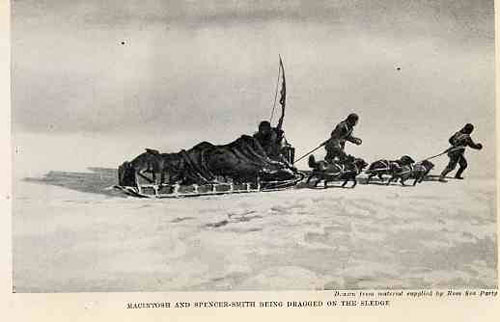
An epic tale
When Shackleton decided to attempt to cross Antarctica he knew he would have to have depots of food and fuel deposited on the other side of the continent if they were to make it across so he sent a separate expedition to Ross Island to achieve this.
The ship Aurora left Hobart on Christmas Day 1914 captained by Aeneas Mackintosh. He had been on Shackleton’s Nimrod Expedition where he lost an eye. Accompanying him was Ernest Joyce, an experienced polar explorer, but Shackleton had been unclear about who was in command and this led to friction.
The expedition Reached Ross Island and settled in to Scott’s hut at Cape Evans. Against Joyce’s advice, Mackintosh pushed the sledge dogs too hard and most of them died. The Aurora was secured to the ice at Cape Evans and contained most of the stores. Unfortunately, a violent storm blew the mooring ice and the ship out to sea, leaving the shore party of ten men alone on the ice with minimal equipment.
They expected the ship to return but it became trapped in ice and would stay that way for a year before returning to New Zealand for repairs. While Mackintosh was out with five of the men laying depots the four others back at Scott’s Hut went through the supplies that Scott had left behind and found tins of jam, flour, and oatmeal, pemmican, cake, chocolate, sleeping bags, socks, underwear, kerosene and primus stoves but no extra clothing.
When Mackintosh and the others returned they cut up a tent and turned it into sledging clothes and extended their supplies by killing seals for meat and fuel.

Their mission was to set up depots for Shackleton but they were unaware that his ship Endurance was also trapped in ice on the other side of the continent and that their would be no crossing of Antarctica. Since they were unaware of this they continued with the mission and planned to transport 1800kg of supplies onto the ice shelf and make their furthest depot at Mount Hope.
One party had to turn back due to a faulty primus because without a primus they could not melt snow for drinking water. Mackintosh’s party reached 82°S but the men were weakening and the chaplain, Spencer-Smith, had scurvy. They left him in a tent and made it to Mount Hope, set up the depot and returned for the chaplain, who by this time could not walk. They transported him on the sledge but he died on the return journey and was buried in the ice.
They finally reached Hut Point and were all suffering from scurvy after having been away for 6 months. After a diet of seal meat they recovered their strength and banished the scurvy (seal meat contains vitamin C).
They would need to wait four months for the sea ice to be thick enough to cross it back to their base at Cape Evans but Mackintosh was impatient and decided to take another member, Hayward, with him and cross the 19 km of sea ice back to Cape Evans. They set out but a blizzard came through and they were never seen again, probably blown out to sea with the sea ice.
The other men waited 2 months and made it back across the ice and met up with the remaining members at Cape Evans where the seven men had to endure a long wait for rescue. The Aurora returned for them in January 1917 and Shackleton was on board, having had his own incredible tale of survival.
The Ross Sea Party was on the ice for longer than any other sledging party, a total of 199 days, without adequate clothing or support, but carried out their mission of depositing food for Shackleton’s expedition that would never arrive. In one sense an epic waste, with three men dead, but in another it was an incredible achievement.

